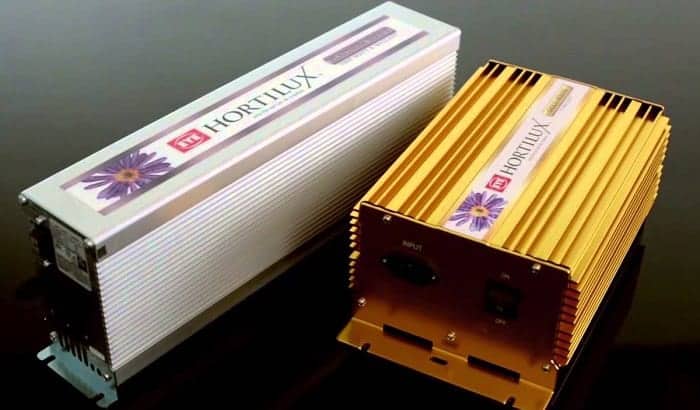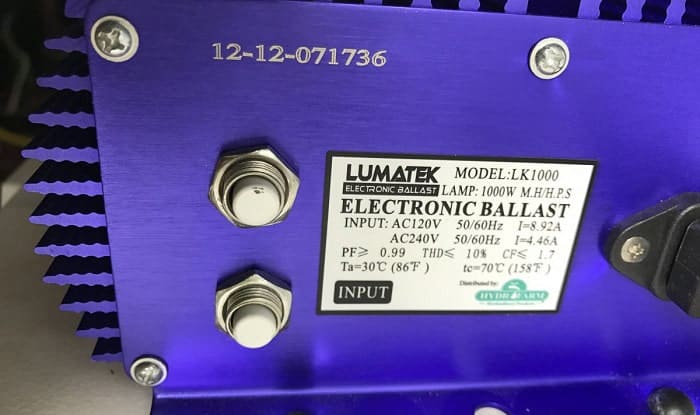How many amps does a 1000 watt ballast use? Can I run my 1000 watt ballast in a standard outlet? And how many 1000 watt lights can I run from my wall plug?
These questions are essential and helpful for growers like you who use HID lighting. You need this information to understand the basics of power and if your current power supply can handle your system. In this article, you will learn the amps you need for a 1000 watt ballast and the critical specifications you must know before buying a new one.
Table of Contents
How Many Amps Do You Need?
Generally, most standard outlets have a capacity of 15 amps. When you plug a 1000 watt ballast into your 110 volts power supply, it draws nine amps. It means you can only run a single 1000 watt ballast in your 15 amp single breaker outlet.
On the other hand, a 220-volt outlet paired with a 30-amps circuit breaker can handle up to six 1000 watt ballasts. This is because a 1000 watt ballast will only draw 4.5 amps when plugged into a 220-volt outlet.
If you want to learn more, this video by Techquickie will show you more about the Amps, Volts, Watts, and other electrical ballasts.
The vital thing before choosing a ballast is to check first the breaker capacity of the circuit you want to use. The breaker should have a higher capacity than your wiring to protect your entire circuit. If you want to be sure, it’s best to hire a professional electrician to look at your system.
However, that is just the tip of the iceberg.
Factors to Consider Before Buying 1000-Watt Ballast
1.Input Voltage
If you want to run a 1000 watt ballast, you must consider your input voltage. Most e-ballasts will accept a range of 105 to 255 volts input voltage. In contrast, Sun System Ballasts can take up to a 285 input voltage via the Smart Volt feature.
Reminder: Always check the specifications of your ballast before plugging it in. Accidentally installing a 110-volt ballast to a 220-volt outlet can lead to catastrophic failure for the ballast.
2. Type of Bulb
Old ballasts are only compatible with a particular type of bulb – either an HPS or a metal halide lamp. If you want to use it for a bulb that it wasn’t designed for, you must have a conversion kit. However, most new ballasts can be used in both types of light sources.
3. Electro-Magnetic Interference (EMI)
A poorly designed e-ballast emits radio interference and noise. These will interfere with your cable, wifi, and other electronic communications. If you’re going to install this near your connections, ensure that the brand you purchase has low EMI or excellent shielding.
4. Wattage Capabilities
Can it run in different wattage lamps? Most modern e-ballast has a watt selector that can let you use any bulb up to 1000 watts. There’s also a ballast with a power boost or turbo features that allows up to 1150 watts.
Personally, I prefer ballasts with this feature, so I can dim my lighting based on my needs or use auto-dim when my bulb gets too hot.
5. Cable Length
Some ballasts come with a 6-foot cable to connect them to the lighting system, while others have 12 feet of wiring. Plan your lighting system ahead before purchasing so that you can order the correct cable lengths you need at the start.
6. Circuit Breaker
Some ballast has a built-in breaker, and it can help your ballast avoid hot restrikes. If the ballast has a mechanism like this, it is smart enough to cool down before restriking the lamp automatically. Furthermore, this also helps avoid damage to your lights due to power outages.
7. Sockets and Fixtures
Many e-ballast manufacturers are making sockets exclusively for their brand lighting fixtures. If you have existing fixtures, check if the ballasts you’re planning to buy are compatible with them.
8. Controller Compatibility
Some e-ballast and integrated lighting fixtures are connected to their electronic controller via telephone cables. Make sure that your system does not require proprietary connectors and other hardware before making any purchase.
To help you find the ballast that fits your lighting system, check my top-rated 1000 Watt Ballasts articles, where I share my experience working with different ballasts. This will give you a better idea about each brand and its features.
Conclusion
Now you know how many amps does a 1000 watt ballast use, plus the other factors to consider when choosing a ballast. I highly recommend going through the perfect 1000 Watt Ballast reviews to help you find the ballast you need quickly.
Finding the right ballast for your circuit breaker is essential. Because if you plug a high-wattage ballast and your circuit is not designed for it, your whole system might get damaged. It’s best that you first determine the specifications you need before making a choice.

I am Andrew Wright. With 8 years of experience designing, installing, and maintaining electrical power systems. I love my job, and I have always wanted to offer others the necessary help so they can take care of their houses.


